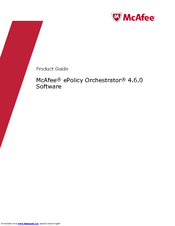McAfee ePolicy Orchestrator 4.6.0 Manuals
Manuals and User Guides for McAfee ePolicy Orchestrator 4.6.0. We have 1 McAfee ePolicy Orchestrator 4.6.0 manual available for free PDF download: Product Manual
Advertisement
Advertisement
Related Products
- MCAFEE EPOLICY ORCHESTRATOR 4.0 - LOG FILES FOR
- MCAFEE EPOLICY ORCHESTRATOR 4.5 -
- MCAFEE EPOLICY ORCHESTRATOR 4.5 RELEA
- MCAFEE EPOLICY ORCHESTRATOR 4.0.2 -
- MCAFEE UTILITIES 4.0
- McAfee Endpoint Encryption for Files and Folders 4.0.0
- MCAFEE EPOLICY ORCHESTRATOR 4.0 PATCH 5 - S 12-05-2009
- MCAFEE EPOLICY ORCHESTRATOR 3.6 - WALKTHROUGH GUIDE
- McAfee ePolicy Orchestrator 4.0
- McAfee ePolicy Orchestrator
